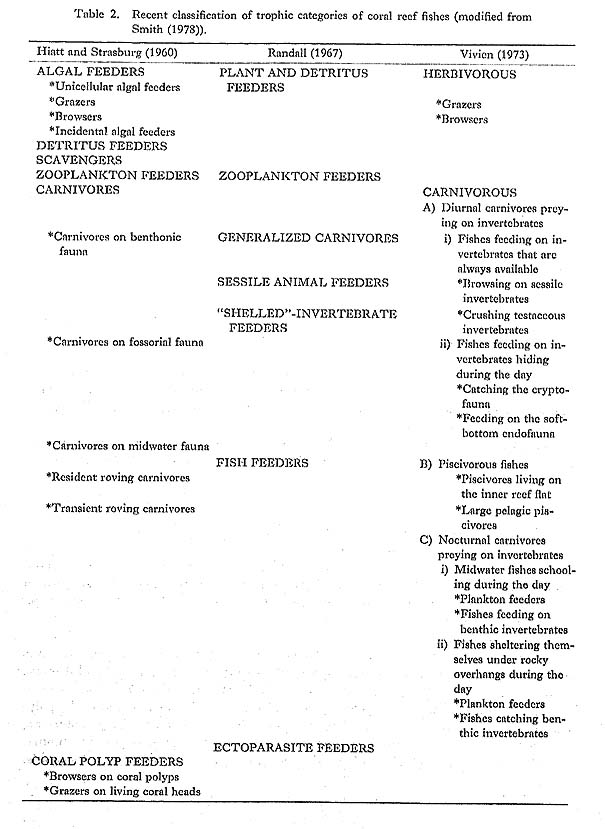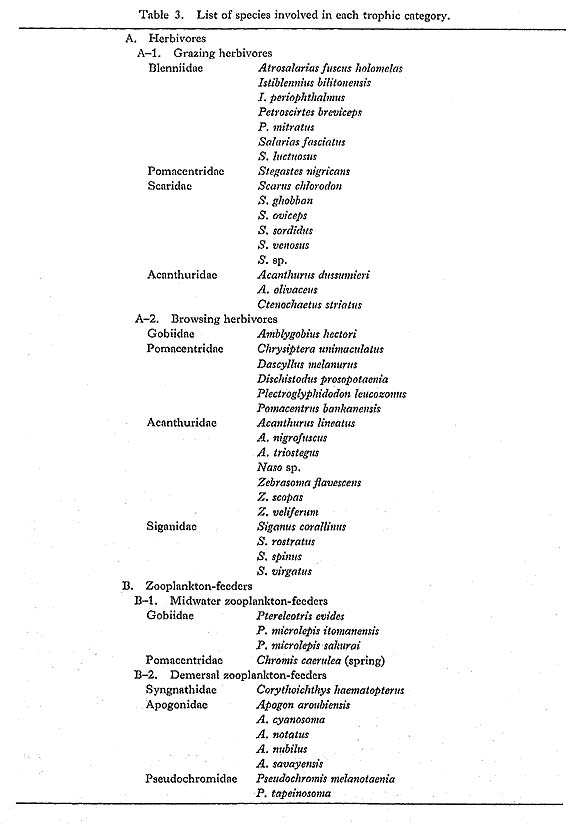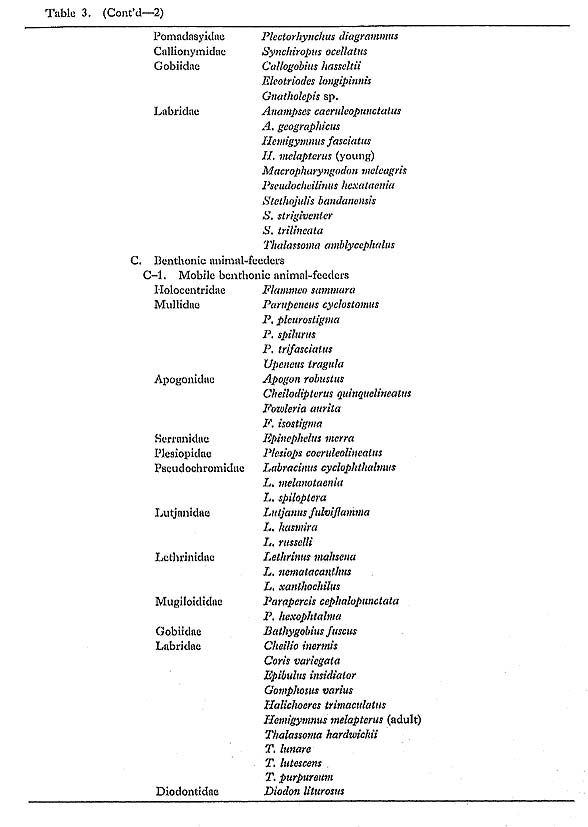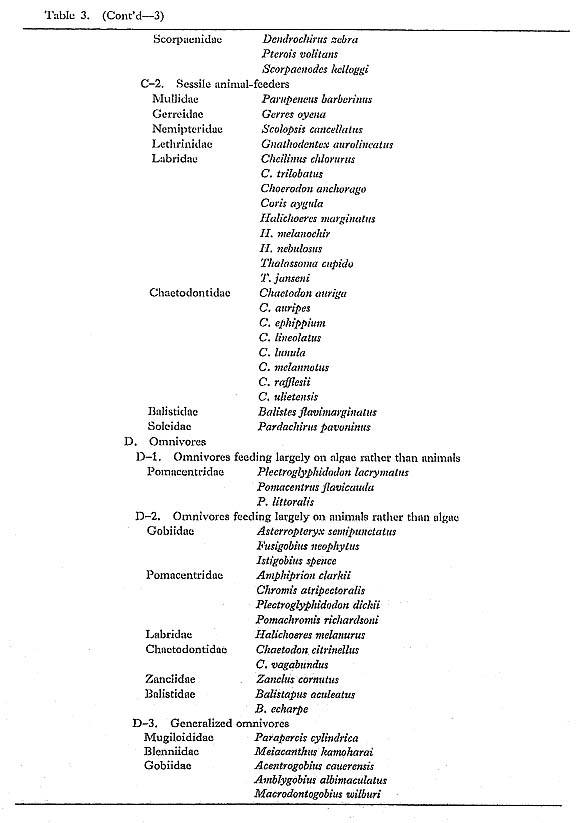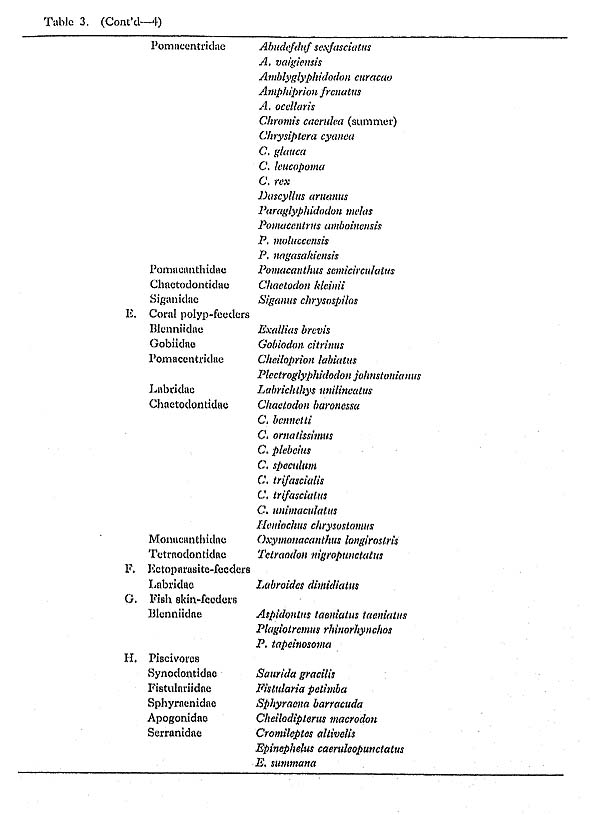CHAPTER IV
Classification of Trophic Categories
|
Classification of the trophic categories of fishes associated with coral reefs has been done by a few workers, i.e., Hiatt and Strasburg (1960) in the Marshall Islands, Randall (1967) in the West Indies, and Vivien (1973) in Madagascar (Table 2), As noted by Smith (1978), such classifications arc somewhat different in each locality. We classify the reef fishes examined at Minatogawa into the following eight categories on the basis of gut content analysis, and furthermore subdivide some categories into the two or three groups. Species in each category are listed in Table 3.
A. HerbivoresThis category can be segregated into two groups, grazing and browsing herbivores, based on the feeding mechanism and diet composition. A-1. Grazing herbivores A-2. Browsing herbivores B. Zooplankton-feedersThis category can be subdivided into the following two groups. B-1. Midwater zooplankton-feeders B-2. Demersal zooplankton-feedera C. Benthonic animal-feedersThis category has often been subdivided into several groups (Table 2), because the species involved in this category hunt a great variety of prey by various feeding strategies. For example, in the West Indies Randall (1967) classified this category into three groups. The first group was sessile animal feeders that subsist primarily on sponges, anthozoans, tube-dwelling polychaetes, gorgonians, and tunicates. The second was "shelled"-invertebrate feeders that prey by crushing mostly gastropods, pelecypods, eehinodcrms, crabs, and hermit crabs with their jaws or pharyngeal teeth. The third was generalized carnivores that capture a variety of mobile benthonic animals such as crustaceans, worms, and small fishes. We can also segregate this category into two groups-mobile benthonic animal-feeders and sessile animal-feeders-according to the degree of prey mobility. C-1. Mobile benthonic animal-feeders C-2. Sessile animal-feeders D. OmnivoresAll species in this category contain both algal and animal diets in their digestive tracts. We can subdivide it into three groups according to the relative abundance of these two types of prey. D-1. Omnivores feeding largely on algae rather than animals D-2. Omnivores feeding largely on animals rather than algae D-3. Generalized omnivores E. Coral polyp-feedersThese predators feed selectively on only scleractinian coral polyps. In the Marshall Islands Hiatt and Strasburg (1960) subdivided this category into three groups. The first group was "browsers" that bite off individual polyps with protruding snouts and teeth projecting from small mouths. The second was "grazers" that scrape off the surfaces of living coral tips. The third was "feeders on branching coral tips" that break off living tips of branching corals with strong or fused teeth. In the present study most coral polyp-feeders have browsing habits, but the blenniid Emllias brevis and the tetraodontid Tetraodon nigropunctatus are placed in the second and third groups, respectively. F. Ectoparasite-feedersThis category is represented by only the cleaner labrid Labroides dimidiatus which removes crustacean ectoparasites from the body, fins, gills, or mouth of other reef fishes. G. Fish skin-feedersThese fish have a highly specialized feeding strategy: They form mimetic associations with harmless or nonpredatory reef fishes and feed by tearing pieces from the body or fins of other fishes. H. PiscivoresThis category includes predators that hunt only small fishes by ambushing or stalking. In the present study, species that capture both fishes and crustaceans such as decapods are categorized as mobile benthonic animal-feeders. |
